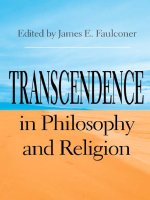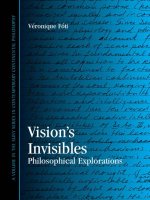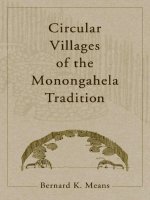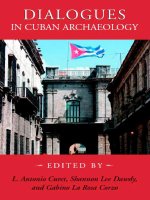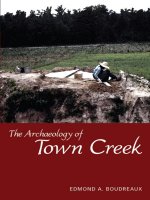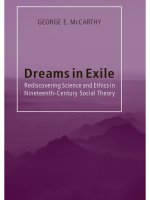university alabama press dialogues in cuban archaeology aug 2005
Bạn đang xem bản rút gọn của tài liệu. Xem và tải ngay bản đầy đủ của tài liệu tại đây (1.7 MB, 264 trang )
DIALOGUES IN CUBAN ARCHAEOLOGY
DIALOGUES IN
CUBAN ARCHAEOLOGY
Edited by
L. ANTONIO CURET, SHANNON LEE DAWDY,
AND GABINO LA ROSA CORZO
THE UNIVERSITY OF ALABAMA PRESS
Tuscaloosa
Copyright © 2005
The University of Alabama Press
Tuscaloosa, Alabama 35487-0380
All rights reserved
Manufactured in the United States of America
Typeface: AGaramond
∞
The paper on which this book is printed meets the minimum requirements of American
National Standard for Information Science—Permanence of Paper for Printed Library
Materials, ANSI Z39.48–1984.
Library of Congress Cataloging-in-Publication Data
Dialogues in Cuban archaeology / edited by L. Antonio Curet, Shannon Lee Dawdy, and
Gabino La Rosa Corzo.
p. cm.
Originally presented at a symposium held at the 2002 Society for American Archaeology
67th Annual Meeting held in Denver, Colorado.
Includes bibliographical references and index.
ISBN 0-8173-1464-4 (cloth : alk. paper) — ISBN 0-8173-5187-6 (pbk. : alk. paper)
1. Indians of the West Indies—Cuba—Antiquities—Congresses. 2. Excavations
(Archaeology)—Cuba—Congresses. 3. Cuba—Antiquities—Congresses. I. Curet,
L. Antonio, 1960– II. Dawdy, Shannon Lee, 1967– III. La Rosa Corzo, Gabino. IV. Society
for American Archaeology. Meeting (67th : 2002 : Denver, Colo.)
F1769.D53 2005
972.91′00497′0729—dc22
2005000438
To the memory of three pillars of Cuban archaeology, Ramón Dacal Moure,
José M. Guarch Delmonte, and Manuel Rivero de la Calle.
List of Figures ix
List of Tables xiii
Acknowledgments xv
1. Introduction
Shannon Lee Dawdy, L. Antonio Curet, and Gabino La Rosa Corzo 1
PART I. HISTORY OF CUBAN ARCHAEOLOGY
2. Three Stages in the History of Cuban Archaeology
Ramón Dacal Moure and David R. Watters 29
3. The Organization of Cuban Archaeology: Context and Brief History
Mary Jane Berman, Jorge Febles, and Perry L. Gnivecki 41
4. Historical Archaeology in Cuba
Lourdes S. Domínguez 62
5. Cave Encounters: Rock Art Research in Cuba
Marlene S. Linville 72
PART II. SUBSTANTIVE ARCHAEOLOGICAL RESEARCH
6. Approaches to Early Ceramics in the Caribbean:
Between Diversity and Unilineality
Jorge Ulloa Hung 103
7. El Chorro de Maíta: Social Inequality and Mortuary Space
Roberto Valcárcel Rojas and César A. Rodríguez Arce 125
8. Mythical Expressions in the Ceramic Art of Agricultural Groups
in the Prehistoric Antilles
Pedro Godo 147
Contents
9. Subsistence of Cimarrones: An Archaeological Study
Gabino La Rosa Corzo 163
10. An Archaeological Study of Slavery at a Cuban Coffee Plantation
Theresa A. Singleton 181
11. Afterword
Samuel M. Wilson 200
References Cited 203
Contributors 229
Index 235
viii / Contents
1.1. Map of Cuba 23
2.1. Work group translating and editing the book titled The Art
and Archaeology of Pre-Columbian Cuba by Dacal Moure and
Rivero de la Calle 39
3.1. Welcome sign, a billboard in central Cuba 42
3.2. The Capitolio, Havana 49
3.3. Dra. Lourdes Domínguez with her husband and her mother 52
3.4. Entrance to the Montané Museum, Havana, Cuba 53
3.5. Entrance to Centro de Antropología, Havana, Cuba 55
4.1. Map of Old Havana showing the areas restored by the O¤cina del
Historiador de la Ciudad de la Habana. 63
5.1. Drawing of the “Motivo Central” of Cueva No. 1, Punta del Este,
Isla de Juventud, Museo Antropológico Montané de la Universidad
de La Habana. 76
5.2. Rolando T. Escardó and Antonio Núñez Jiménez studying pictographs
painted in red in the Cueva de Pichardo, Sierra de Cubitas 79
5.3. Manuel Rivero de la Calle delivering a speech to the Sociedad
Espeleológica de Cuba 80
5.4. Geopolitical map of Cuba indicating Rock Art zones 87
6.1. Map showing the location of many early ceramic sites in
eastern Cuba 104
6.2. Flaked stone tools from Canímar I 110
Figures
6.3. Examples of ceramic decorations from the Belleza site, Santiago
de Cuba 113
6.4. Examples of ceramic decorations from the Abra del Cacoygüín site,
Holguín, Cuba 114
7.1. Map of the Province of Holguín showing the location of the Area
Arqueológica de Banes and the Yaguajay zone 130
7.2 Map of the Yaguajay Zone showing the location of
archaeological sites 133
7.3. Sketch of Excavation Unit 3 with the distribution of burials and associated
objects from El Chorro de Maíta cemetery 135
7.4. Objects associated with burials from El Chorro de Maíta cemetery 138
8.1. Examples of turtle-theme handles from El Morrillo 149
8.2. Syncretism of the coil handle and turtle theme from El Morrillo 149
8.3. The basic turtle representational unit and its variations 150
8.4. Batrachiform designs on burenes or clay griddles and other artifacts 153
8.5. Batrachiform designs 154
8.6. Reconstruction of the design on burenes associated with the
schematization of batrachians 154
8.7. Batrachiform designs 155
8.8. Ceramic vessel with anthropomorphic handles (twins) and paneled motifs
of frog legs from a cave in Baracoa, Cuba 156
8.9. Anthropomorphic images of crying/raining 156
8.10. Anthropomorphic images of crying/raining 158
8.11. Images of crying/raining with anthropozoomorphic features 158
8.12. Crying ¤gure designs 160
9.1. Map of Cuba showing the location of the sites discussed 164
9.2. Total number of remains (NISP) and minimum number of
individuals (MNI) 169
9.3. MNI by species in all the studied sites 169
9.4. Distribution of MNI by species for each of the studied sites 170
9.5. Distribution of bone and fragment sizes by site 171
9.6. Degree of completeness of the bones identi¤ed by site 172
9.7. Distribution of burn marks in all sites 172
9.8. Distribution of burn marks by site 173
x / Figures
9.9. Butcher marks by site 174
10.1. Map of the Cafetal del Padre 182
10.2. Picture of the wall surrounding the slave village at the Cafetal
del Padre 183
10.3. Picture of the wall surrounding the slave village at the Cafetal
del Padre 184
10.4. Picture of the wall surrounding the slave village at the Cafetal
del Padre 185
10.5. Map of the Cafetal del Padre showing the location of the
excavation units 188
Figures / xi
3.1. Licentiate in history curriculum, University of Havana 51
3.2. Curriculum for students specializing in archaeology, University
of Havana 51
5.1. Table of Cuban Rock Art 82
5.2. Table of early terminological equivalents in Indocuban research 89
9.1. Number of remains (NISP) and minimum number of individuals (MNI)
in the studied sites 168
Tables
B
oth the spirit and the reality of this project correspond to a collaborative
team project. Many individuals and organizations have lent their support and
enthusiasm to its inception, realization, and transformation from a conference
symposium to an edited volume. The symposium and related forum out of
which this volume grew took place at the 2002 Society for American Archae-
ology 67th Annual Meeting held in Denver, Colorado. The travel and partici-
pation of the Cuban presenters was made possible by a generous grant from
the American Council of Learned Societies and Social Science Research
Council’s Working Group on Cuba. The sources of the funds made avail-
able were the John D. and Catherine T. MacArthur Foundation and the
Christopher Reynolds Foundation. Staff member Rachel Price of the ACLS/
SSRC was encouraging and helpful at every point along the way.
Cuban organizations such as the Centro de Antropología de Cuba and the
Gabinete de Arqueología de la Habana also lent their logistical and ¤nancial
support toward preparing travel arrangements for the Cuban participants.
The leadership and staff of the Society for American Archaeology were
extremely supportive of the endeavor, offering of¤cial sponsorship of the
symposium, extending hospitality to the participants, and helping to accom-
modate the needs of a bilingual session. SAA President Bob Kelly was par-
ticularly gracious and enthusiastic, opening the session with introductory
comments in Spanish. The dif¤cult task of real-time translation fell to Gustavo
Gamez. Others participated in the round-table forum following the sympo-
sium which established a consensus and sense of urgency in support of this
Acknowledgments
publication. Daniel Sandweiss of the University of Maine and Sean Britt of
Earthwatch Institute made substantial contributions to the discussion.
Shannon Lee Dawdy, who organized the conference events, received logis-
tical support from the University of Michigan’s Institute for the Humanities
and travel funds from the Rackham School of Graduate Students during
2001–2002. Her own trip to Cuba in 1999 that led to her friendship with
Gabino La Rosa and the idea for the symposium was supported by a Latin
American and Caribbean Studies pre-dissertation award from the University
of Michigan’s International Institute. She would not have gone to Cuba had
it not been for the buoyant advising of Rebecca Scott. In Cuba, Marcos
Rodríguez Matamoros and Lester Puntonet Toledo shared their knowledge of
Cuban archaeology and helped set a path for this project in ways of which
they are probably unaware and for which she is deeply grateful. Shannon
would also like to thank her brother, Jess Dawdy, who provided childcare in
Denver under some dif¤cult, if humorous, conditions.
The editors are grateful that all of the original symposium presenters
(Mary Jane Berman, Ramón Dacal Moure, Lourdes Domínguez, Jorge Febles,
Perry L. Gnivecki, Pedro Godo, Gabino La Rosa Corzo, Theresa Singleton,
and David Watters) agreed to submit their contributions for publication. It
was clear in the early stages of the preparation of this volume that additional
authors were needed in order to include a wider representation of Cuban ar-
chaeology, and the decision was made then to invite several other colleagues
to contribute to this publication. The editors would like to thank these addi-
tional contributors—Marlene Linville, César Rodríguez Arce, Jorge Ulloa
Hung, Roberto Valcárcel Rojas, and Samuel M. Wilson—for graciously ac-
cepting our invitation to participate in this publication. More than anything
we deeply appreciate the patience, understanding, and support of all these dis-
tinguished authors during the whole process in the preparation of this volume.
The editors also express their gratitude to Judith Knight, acquisition editor
at The University of Alabama Press, for her support of this project from the
beginning and for her patience. José Oliver, Kathleen Deagan, and an anony-
mous reviewer provided valuable and important comments that strengthened
the quality of the volume. We would also like to thank Tisha Smith and
Louise Elinoff for their assistance in preparing the list of references cited and
Daniel McNaughton for ¤nal proofreading. Jill Seagard, Scienti¤c Illustrator
of the Department of Anthropology of the Field Museum of Natural History,
deserves credit for the ¤nal versions of Figures 1 .1 and 4.1 .
xvi / Acknowledgments
DIALOGUES IN CUBAN ARCHAEOLOGY
This volume evolved out of a symposium titled “Prehistoric and Historic
Archaeology of Cuba: A New Era of Research, Dialogue, and Collaboration”
presented at the Annual Meeting of the Society for American Archaeology in
2002. The goal of the symposium was to provide a setting for Cuban and
American archaeologists to engage in a dialogue that could help thaw the state
of communication between scholars from both countries, which in many
ways has remained frozen in the political climate of the early 1960s. The sym-
posium also provided an opportunity to present a retrospective on the history
of Cuban archaeology, as well as results of recent research. This volume shares
the aims of the symposium, but it also has the goal of raising awareness
among American archaeologists about the current social, political, and aca-
demic state of archaeology in Cuba. In particular, we want to present a more
precise picture of Cuban archaeology since the beginning of the Revolution
in order to redress some of the misunderstandings, mistrust, and myths cre-
ated by the absurdities of the Cold War and its lingering ghosts.
SOCIETY AND ARCHAEOLOGY:
INTERACTION BETWEEN CUBAN AND AMERICAN
ARCHAEOLOGISTS UNDER THE EMBARGO
For some time now, archaeologists and social scientists have recognized that
the social, political, and economic context of their work can and does affect
many aspects of research, including the questions being asked and the results
1 / Introduction
Shannon Lee Dawdy, L. Antonio Curet, and Gabino La Rosa Corzo
obtained from their studies. In many cases, paradigms, research topics of in-
terest, methodology, results, and conclusions are in®uenced by our personal
and social conditions (e.g., Trigger 1989). However, these conditions can also
affect the shape and trajectory of research in another way, by determining, at
least indirectly, with whom we interact professionally. Social biases inevitably
in®uence communication and interaction with other scholars, according to
how our social perspective and background agree with those of colleagues.
Ultimately, the terms, composition, or even lack of interaction between schol-
ars can greatly in®uence the historical and intellectual development of an aca-
demic discipline. Within archaeology, few examples of how the lack of com-
munication can affect the development of a ¤eld are more dramatic than the
case of Cuban and North American archaeologists separated by the U.S.
embargo.
The ongoing U.S. embargo of Cuba is an anachronism from the Cold War
that affects everyone living in the island and a large number of people living
in other countries. Before the 1960s, Cuba depended heavily upon products
manufactured in the United States. In fact, the small island nation was one of
the largest trading partners of the United States, particularly in the exchange
of agricultural products (Forster and Handelman 1985). This economic inter-
dependency was entangled with a long history of American interest in Cuba
that included military interventions and signi¤cant control over the political
and economic life of the island dating back at least to the 1870s. American
in®uence was so strong that pre-Revolutionary Cuba is considered by many
scholars to have been a modern colony of the United States (Pérez 1999). In
1959, Fidel Castro’s Partido del Pueblo Cubano (Party of the Cuban People)
came to power as a result of a revolutionary war against President Fulgencio
Batista, now generally acknowledged to have been a brutal and inept dicta-
tor propped by the Eisenhower administration. Under Batista, the poverty of
the Cuban people reached an all-time postcolonial low, with hunger and mal-
nutrition widespread in 1950s Cuba (Forster and Handelman 1985:176; Wilkie
and Moreno-Ibáñez 1985:79).
Within a few years of Batista’s ouster, Castro began to establish a close
relationship with the Socialist Party and the Soviet Union as U.S. political,
military, and economic pressure mounted, including the failed Bay of Pigs
invasion. A seizure of U.S. corporate assets and Cuba’s growing alliance with
the USSR soon led to the famous Cuban Missile Crisis of 1962. It was during
this crisis that President Kennedy began the embargo of Cuba, banning the
trade of all American products and businesses with Cuba, as well as travel to
2 / Dawdy, Curet, and La Rosa Corzo
the island by most U.S. citizens, a move that has lasted in a modi¤ed version
until the present day. For a relatively small nation whose whole industrial
and agricultural infrastructure was based upon U.S. technology and designs,
this sudden and severe break in economic and political relationships was dev-
astating. For the average Cuban citizen in the 1960s, the embargo meant that
basic products such as medicine, food, clothing, chemicals, fuel, and even
clean water suddenly became unavailable. For the Cuban citizen of today,
“El Bloqueo” means that many of these items are scarce, absurdly expensive,
of poor quality, or available only sporadically. Although Cuba has survived
by creating strong trade relations with other nations, the exclusion from the
world’s largest economy located just 90 miles away still means that the Cuban
people suffer shortages in essential goods. The embargo is now perpetuated
for quite different reasons than it was at the beginning, through the lobbying
of Cuban exiles in the United States who are critical of the Revolutionary
government, many of whom also hope to regain family property (and perhaps
power) lost in the 1960s.
Despite frequent media coverage of the political tensions between the
United States and Cuba and an outpouring of scholarly works on the history
of Cuban-American relations, many Americans remain unaware of the eco-
nomic, political, and personal impact of the embargo on everyday life in
Cuba. Even less is said about how the “communication blockade” between
scholars has affected the historical course of academic disciplines and scholar-
ship in general. Communication between colleagues and the sharing of re-
search results and ideas are critical to the advancement of all disciplines. The
absence of regular avenues for scholarly exchange can slow the processes of
discovery, theory-building, testing, and critique that are important to the ma-
ture development of a ¤eld. Unfortunately, the lack of communication be-
tween two generations of Cuban and U.S. scholars has led not only to a near
silencing of scholarly exchange but also to a misunderstanding about the con-
ditions underlying this silence. For example, in his review of archaeology in
post-1959 Cuba, Davis (1996) argues, among other things, that this state of
affairs is due to a voluntary isolation adopted by his Cuban counterparts. Ar-
chaeologists who have traveled to Cuba in the past few years have found this
assumption to be false. Cuban archaeologists are eager, even hungry, for intel-
lectual exchange and information on the state of the ¤eld in North America.
The perception that Cuba’s isolation is self-imposed rather than a condition
structured by the U.S. embargo is a relic of Cold War rhetoric.
New archaeological ¤ndings and methods have been developed in many
Introduction / 3
areas of study in both countries, but the gap in scholarly communication has
limited the potential contribution that each side could make to the mutual
bene¤t of theoretical and methodological discourses. For instance, greater
scholarly interaction between Cuba and the United States during the 1960s
and 1970s (dif¤cult years for American archaeology and the social sciences in
general) could have molded different historical trajectories of the discipline.
On the one hand, Cuban archaeology could have bene¤ted from many of the
developments in American archaeology that resulted from the debate over
New Archaeology and the development of Cultural Resource Management
archaeology (Flannery 1973; Plog et al. 1978; Schiffer 1976). On the other
hand, American archaeology could have pro¤ted from many of the early theo-
retical works developed in Cuban archaeology and anthropology that focused
on themes such as transculturation, increasing social complexity, and the cul-
tural impact of the African Diaspora (Ortíz 1943; Tabío and Rey 1966). This
is not to say that during this time period no advancements were made or even
that Cuban and American archaeologists were oblivious to developments else-
where. Our argument here is rather that the nature of the developments and
debates in the discipline could have been considerably different, and probably
richer, if the channels of communication had been open at key moments in
the history of archaeology.
CUBAN CONTRIBUTIONS TO ARCHAEOLOGY
It is important to point out some of the contributions Cuban archaeology has
made to the study of past societies and to the discipline at large. As can be
seen from the papers in this volume by Dacal Moure and Watters (Chapter 2),
Berman et al. (Chapter 3), Domínguez (Chapter 4), and Linville (Chapter 5),
Cuban archaeology has a long scholarly and institutional tradition that dates
back to the nineteenth century. In addition to trajectories in research and
education, Cuba has a long tradition in conservation and cultural resource
management, as Dacal Moure and Watters point out (see also Linville, Chap-
ter 5, on the conservation of rock art). In fact, Cuban laws for the protection
and regulation of archaeological heritage appear to be stricter than those of
the United States.
In terms of the Caribbean, Cuban archaeology has led the ¤eld in some
areas of important research. Innovative Cuban studies of lithic and shell as-
semblages in a region where ceramics monopolize discussion appear as an
oasis in the desert. Another example is the government-sponsored program of
4 / Dawdy, Curet, and La Rosa Corzo
the Censo de Sitios Arqueológicos, which has resulted in a sizeable computer-
ized database; it should serve as a model for recording and inventorying
archaeological sites throughout the Caribbean (see Dacal and Watters, Chap-
ter 2).
In the realm of theory, Cuban archaeologists have applied the concept of
transculturation, developed for the ¤rst time by the Cuban anthropologist
Fernando Ortíz (1943), to the interaction of ancient groups. Transculturation
has been used successfully to explain many changes in late Archaic and Co-
lonial times that resulted from the interaction between groups within Cuba
and with those from neighboring islands (e.g., Rey 1970; Ulloa Hung and
Valcárcel Rojas 2002). Cuban archaeologists have brought the issue of culture
change to a higher level of discussion, especially in dealing with protoagricul-
tural societies or with Archaic pottery-makers (see Ulloa Hung, Chapter 6;
Ulloa Hung and Valcárcel Rojas 2002).
Another major contribution is in the area of historical archaeology (Do-
mínguez, Chapter 4). In general, historical archaeology has been poorly ap-
preciated in the Caribbean and other parts of the Americas, but the works of
Cuban archaeologists dealing with topics such as the hacienda system (see
Singleton, Chapter 10), slavery and escaped slaves (La Rosa Corzo, Chap-
ter 9), and urban processes (Domínguez, Chapter 4) have in many ways an-
ticipated developments in the North American branch of this ¤eld by a
decade or more. Of special interest are recent renovation projects in Old Ha-
vana that have integrated in an exemplary manner the work of historians,
architects, and archaeologists (Domínguez, Chapter 4). Although it is true
that other pioneering works tied to historic renovations exist (e.g., Ricardo
Alegría’s work in Old San Juan, Puerto Rico), most of these have focused on
architectural restoration rather than on a scholarly, multidisciplinary study of
colonial urban settlements. In terms of its multidisciplinary nature, the joint
project between the Cuban government and UNESCO is serving as a model
for restoration of other colonial zones in the Americas.
ON INTERNATIONALISM, POLITICS,
AND THE PRACTICE OF ARCHAEOLOGY
To qualify our critique of American perceptions of Cuban scholarship, we
should acknowledge that in recent years archaeologists have become increas-
ingly sensitive to the political context of their work, both intellectually and in
terms of practice. Critical assessments of “nationalist archaeology” in differ-
Introduction / 5
ent parts of the globe, such as those made by contributors to the volume Na-
tionalism, Politics, and the Practice of Archaeology (Kohl and Fawcett 1995; see
also Fowler 1987; Gathercole and Lowenthal 1990; Kohl 1998; Meskell 1998),
have shown how archaeology plays a part in forming “imagined communi-
ties” (Anderson 1983) of nations and ethnic communities. A growing sensi-
tivity to nationalist politics has put archaeologists on their guard, ready to cast
doubt on research that smacks of undue boosterism or patriotism. But two
problems remain unresolved by this criticism. First, the closely related prob-
lem of international politics remains relatively neglected—especially in the
¤eld of Americanist archaeology. Nations, nationalism, and nationalist ar-
chaeology do not arise in a vacuum; rather they are creations de¤ned in part
by their opposition to other nations and, we must allow, other “archaeologies.”
A second problem arises out of the epistemological assumptions made in cri-
tiquing “nationalist” scholarship. Critics have attacked participating scholars
as “distorting the past” (Kohl and Fawcett 1995:13). They exhort that archaeo-
logical interpretation should “adhere to scholarly standards of logic and evi-
dence” (Silberman 1995:250). But this remonstrance then begs the question:
whose scholarly standards of logic and evidence? Who ought to decide what
the priorities and standards of archaeology should be? Is it possible to reach a
consensus on archaeological practice without regard to national contexts?
The dominance of North American and European funding, publication,
and organizational power in archaeology would certainly favor the “stan-
dards” of archaeologists living in the West. However, there is no guarantee
that just because a disciplinary culture is dominant that it is any less political.
A long history of claims-making in Western academia shows that many inter-
pretations or policies asserted to be derived from “objective” standards, or ob-
servations of the “natural” order of things, were later revealed to be anything
but disinterested in their design. In working toward global standards of ar-
chaeological practice, we must be wary of unilateralism, and we must base
consensus on actual conversations with colleagues from around the world.
An understanding of these two problems frames the intent of this volume,
both in the spirit in which it is offered and in the model of “dialogue” that it
follows. Few nations in the last 50 years have had such a constant oppositional
relationship in the realm of politics than have Cuba and the United States,
yet archaeologists have hesitated to acknowledge how much this tension has
affected the ¤eld.
With the recent focus on nationalist archaeology, one might overlook that
an earlier phase of criticism focused on the more complex question of inter-
6 / Dawdy, Curet, and La Rosa Corzo
